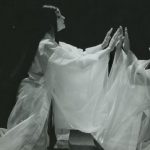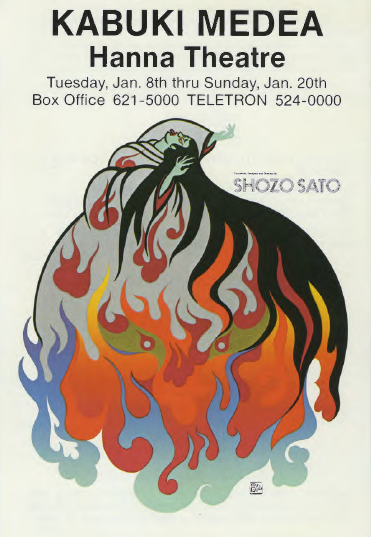Written by Nick Hopkins

Shozo Sato’s (1933- ) contributions to the performing arts have spanned a long, path-breaking career. A Professor of Art and Design at Illinois for 50 years, Sato gained international attention for his adaptation of classic western theater plays into Kabuki performances. In the process, Sato produced a new, hybrid genre of performance that blurs the boundaries between classical Western and Japanese theatres.
The Japanese director came to Illinois in 1964 as an artist-in-residence. With the opening of the Krannert Center for Performing Arts in 1969, he shifted his attention to theatre production. In 1978, he and a student cast performed “Kabuki Macbeth” at Krannert. The performance generated positive reviews in Champaign County, and went on to win three of Chicago’s J. Jefferson awards, for best production, director, and costuming. The success of “Kabuki Macbeth” put the director on the map.

Sato’s next production, “Kabuki Medea” (1982), played at the Berkeley Repertory Theatre, Chicago’s Wisdom Bridge Theater, and at the Natal Performing Arts Center in Durbin, South Africa, winning awards from each. A Chicago Tribune critic was captivated by the play’s “boldly painted makeup and richly colored costumes for the principal actors and chorus, as well as elaborate puppets and hand props.” He added that the drama transported audiences “from a joyous wedding celebration to an underwater battle with a sea monster, to the ritual murder of Medea’s two children.”
After his first production, Sato embarked on more than two decades of remarkable, creative work. He directed “Kabuki” productions of Western classics (Othello, Romeo and Juliet, Lady Macbeth, Euripides) and operas (“Madame Butterfly”) and toured as far afield as India, Germany, and Japan.
Sato’s productions were more than adaptations. Under his direction, classic performances were given new choreography, set design, and lighting, and at times the dialogue was revised to fit the classic Japanese settings. The productions also reflected Sato’s dedication to detail in costume design, set construction and choreography. He also reimagined classic Kabuki performances, revising dialogue, shifting the gender of lead characters and punctuating performances with original turns.

Sato’s artistic innovations have extended beyond theatre. He has published works on calligraphy, flower arrangement, Sumi-e (ink wash) painting, cross-cultural studies, and the art of the traditional Japanese tea ceremony. Much of this activity has emanated from Japan House on the Illinois campus where he served as founding director. In 2003 the Japanese government awarded Sato its first ever Cultural Achievement Award, citing his international dissemination of traditional Japanese culture.
Sources:
1. “Sato Resume, 2008.” University of Illinois Archives, 12/12/21. Box 1, Folder 1.
2. “Sato Biography, Undated.” University of Illinois Archives, 12/12/21. Box 1, Folder 1.
3. “Kabuki Medea Theater Bill, 1983.” University of Illinois Archives, 12/12/21, Box 5, Folder 2
4. Karl Lebovitz, “Greece Meets Japan.” Charleston Times-Courier, 1983. University of Illinois Archives, 12/12/21, Box 5, Folder 8.
5. Richard Christiansen, “Kabuki Media a Bold Triumph.” Chicago Tribune, 1983. University of Illinois Archives 12/12/21, Box 5, Folder 10.
6. “Pictures from Kabuki Macbeth.” Undated. 12/12/21, Box 5, Folder 12.
7. Saher Khan, “Nick Offerman gives the gift of wit and woodwork.” 10/24/13 Daily Illini. http://www.dailyillini.com/article/2013/10/nick-offerman-gives-the-gift-of-wit-and-woodwork
8. “Photo: Shozo Sato and Kabuki Theater actors, 1969.” University of Illinois Digital Archives. http://archives.library.illinois.edu/archon/index.php?p=digitallibrary/digitalcontent&id=1297
